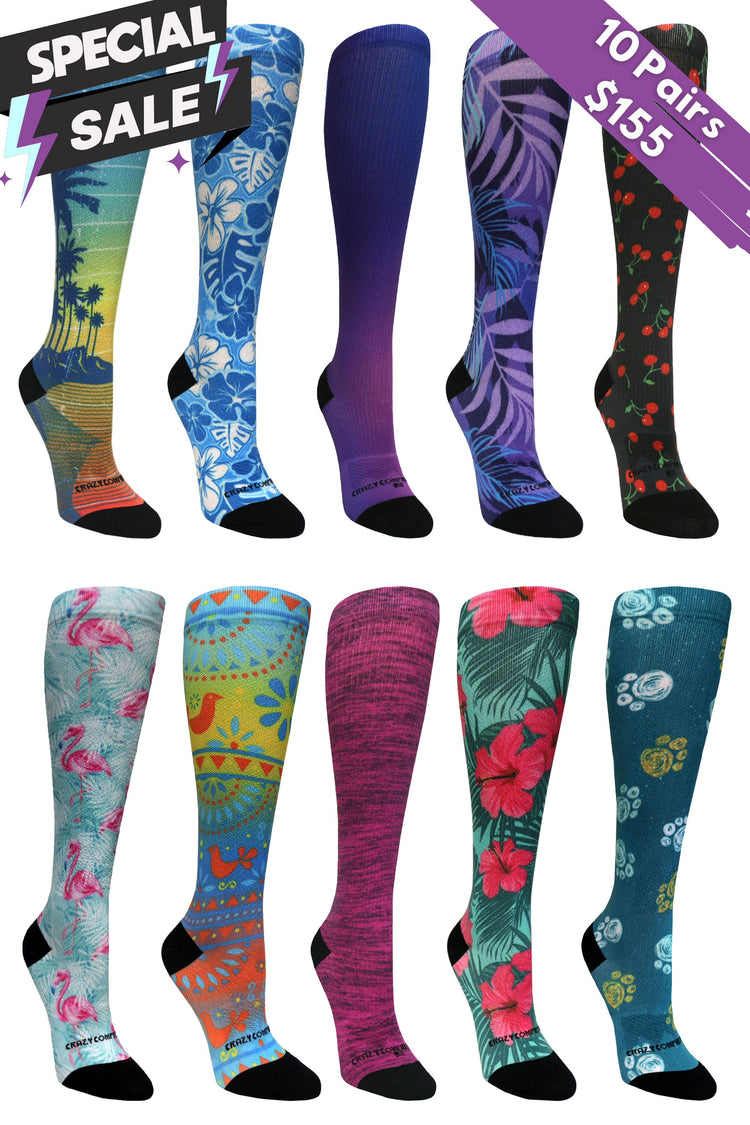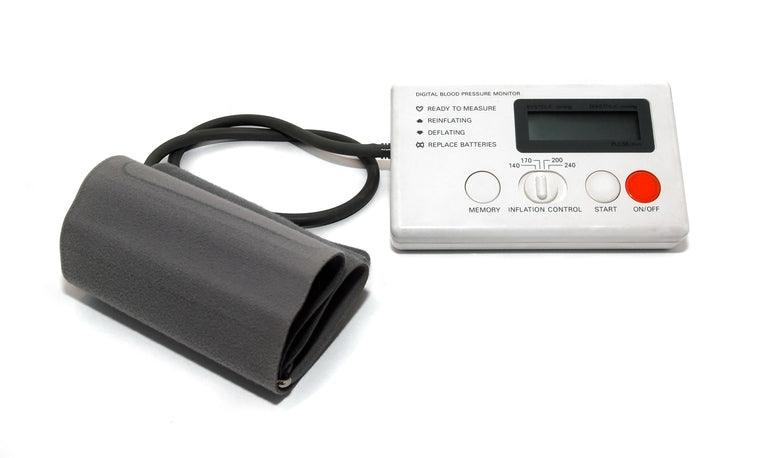Compression socks have become famous for boosting athletic performance and managing conditions like swelling and poor circulation. But do compression socks affect blood pressure?
Compression socks can slightly elevate blood pressure by gently constricting blood vessels. Let's examine how this works and who might benefit from it.
Do Compression Socks Affect Your Blood Pressure Readings?
Compression sleeves or socks can raise blood pressure by 5-10 mmHg. This may be apparent if you take a blood pressure reading without wearing the socks and then later while wearing the socks. By applying gentle compression, leg sleeves or socks narrow the veins in your legs ever so slightly, increasing the pressure created by your blood flow.
This can benefit someone with chronically low blood pressure, also called hypotension, helping them manage their symptoms.
How Compression Socks Work
Compression socks apply pressure to your legs, starting at your ankles and gradually decreasing pressure up your calf. This is known as graduated compression. The goal is to help your veins work more efficiently, pushing blood back toward your heart and preventing fluid buildup in the legs. People commonly use compression socks to manage conditions like varicose veins, deep vein thrombosis (DVT), and lymphedema, all of which doctors have linked to poor circulation.
Do Compression Socks Lower Blood Pressure?
There is evidence that wearing compression socks can slightly raise, rather than lower, your blood pressure. However, regularly using compression socks may help to improve your circulation by aiding your body's ability to pump blood between your legs and your heart, which doesn't have to pump so hard. This can ease pressure on your cardiovascular system and reduce the strain on your heart.
However, wearing compression socks alone cannot treat high or low blood pressure. Consult your doctor instead for an effective treatment plan.
Common Conditions Compression Socks Help With
Compression socks effectively manage several conditions with links to poor circulation, blood pressure problems, swelling, or inflammation. These include:
- Deep vein thrombosis (DVT): Compression socks help prevent blood clots in the deep veins, particularly during long periods of inactivity, such as flying or bed rest.
- Varicose veins: By compressing your veins, these socks prevent blood from pooling, which can cause your veins to enlarge and become painful.
- Lymphedema: Compression socks reduce chronic swelling caused by fluid buildup in your lymphatic system. This condition can occur after surgery or due to certain diseases.
- Venous insufficiency: Compression socks support venous return, helping blood flow back to your heart more efficiently. This reduces venous insufficiency symptoms like swelling, aching, and heaviness in your legs, which can occur when your veins struggle to circulate blood properly, often due to weakened or damaged vein walls.
- Dizzy spells: Compression socks can prevent blood from pooling in your legs, stabilizing your circulation and reducing your chances of experiencing dizziness or fainting when standing.
- Muscle fatigue: Wearing exercise compression socks during physical activities can help to reduce muscle fatigue and promote faster recovery.
Do Compression Socks Raise Blood Pressure?
Applying gentle pressure to your legs while wearing compression socks can elevate your blood pressure slightly (about 5-10 mmHg). Still, this increase cannot cause hypertension (high blood pressure).
For people with hypertension, wearing compression socks typically does not pose any risk. However, those with certain conditions — such as peripheral vascular disease (PVD) and a narrowing of the arteries in the limbs — should avoid compression socks, as the pressure can worsen their symptoms.
Doctors sometimes prescribe compression socks to prevent DVT, a condition that can elevate blood pressure due to blood clots in the deep veins. Compression socks can help prevent the sudden spikes in blood pressure associated with DVT by improving circulation and reducing the risk of clotting.
Who Should Use Compression Socks for Blood Pressure?
Always ask your doctor before committing to any compression sock routine. But in general, here are some of the people who may benefit from their use:
- Athletes: Compression socks can boost performance by enhancing circulation, which helps with muscle recovery and reduces fatigue.
- Travelers: Long flights or road trips can cause blood to pool in your legs, increasing the risk of swelling and blood clots. Knowing when to put on compression socks for flying can help maintain circulation during these periods of inactivity.
- Pregnant women: Many pregnant women experience swelling and poor circulation, particularly in the later stages. Compression socks for pregnancy can help alleviate these symptoms by promoting blood flow back to your heart.
- People with varicose veins: Compression socks support your veins and prevent further deterioration, reducing pain and swelling in those suffering from varicose veins.
- People who sit or stand for extended periods: Truck drivers and office workers can benefit from using compression socks to regulate their blood pressure and prevent blood clots.
Who Should Not Use Compression Socks?
While compression socks can be beneficial for many, there are some conditions where they may not be appropriate, such as those who have suffered from:
- Peripheral vascular disease (PVD): People with narrowed arteries in their legs should avoid compression socks, as they can worsen blood flow in these cases.
- Diabetic neuropathy: For individuals with reduced sensation in their feet due to diabetes, it's essential to use compression socks with caution, as neuropathy can make it difficult to notice if the socks are too tight.
- Severe congestive heart failure: Compression therapy can sometimes increase the fluid load on the heart, so patients with heart conditions should consult their doctor before using compression socks.
Always consult your healthcare team first to determine whether or not you might benefit from wearing compression leg sleeves.
Choosing the Right Compression Level
Not all compression socks are created equal. They come in various compression levels, typically measured in millimeters of mercury (mmHg). The most common compression levels include:
- 15-20 mmHg: Mild compression socks are ideal for everyday use, as they reduce swelling from standing or sitting for long periods.
- 20-30 mmHg: Moderate compression socks are standard for more significant circulation issues, such as varicose veins or recovery from surgery.
- 30-40 mmHg: Medical-grade compression socks are typically prescribed by a doctor for managing more severe conditions like DVT or lymphedema.
Before selecting compression socks, it's crucial to consult a healthcare provider to determine the right compression level for your specific needs, especially if you have a medical condition related to blood pressure.
How to Wear Compression Socks for the Best Results
For maximum benefit, wear your compression socks at the right time:
- Morning: Put on compression socks first thing in the morning before swelling starts. This helps prevent blood from pooling in your legs during the day.
- During exercise: Wearing compression socks can improve blood flow, reduce muscle fatigue, and enhance recovery after workouts.
- Long flights or road trips: Compression socks are beneficial during long periods of sitting, such as on flights or car trips. They help prevent DVT and swelling by maintaining circulation when you're not moving much.
Frequently Asked Questions
Can compression cause high blood pressure?
Although wearing compression socks may elevate a blood pressure reading by 5-10 mmHg, compression socks typically do not cause high blood pressure and are generally safe for most people. They help to improve circulation and reduce strain on the heart.
What are the adverse effects of compression socks?
Potential adverse effects include discomfort, skin irritation, or worsened circulation if the socks are too tight or you wear them incorrectly. Compression socks may exacerbate conditions like peripheral vascular disease (PVD).
What do compression socks do for blood pressure?
Compression socks improve blood circulation, and help stabilize blood pressure by preventing blood from pooling in the legs. Still, they do not significantly raise or lower blood pressure for most individuals.
When should you not wear compression socks?
You should avoid wearing compression socks if you have peripheral vascular disease, severe arterial insufficiency, or diabetic neuropathy, as they can worsen your symptoms or cause complications.

































Leave a comment
This site is protected by hCaptcha and the hCaptcha Privacy Policy and Terms of Service apply.